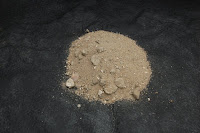
There are a lot of ways of installing silt fence, the problem is that more often than not, it's the wrong way. Ok, so what's so hard about installing silt fence properly. There are a few key things to understand and remember to do it right. The first is that silt fence, as shown in the drawing below is designed to be installed in a trench, typically 6" deep and 6" wide so that the fabric forms an L shape in the trench. The second point is that the back fill over the silt fence in the trench must be compacted in order to secure the fabric properly. The silt fence posts must be located on the downhill side of the fabric, so that the fabric when under water pressure from runoff does not pull away from the stakes securing the fabric. Finally the joining of each length of silt fence (100') must not only overlap, but actually spin the end posts 1 full turn of of the fabric prior to pounding in the stakes.

There are several tricks to installing silt fence properly, and I think one of the best is to trench down 12" and backfill 6", this technique reduces the number of broken stakes considerably.
The second trick is to stretch the fabric straight and level between the stakes, and reinforce the attachment of fabric and stake with a zip tie.
 Remember the next time you see blue sky under the silt fence, it's in wrong and will do nothing to minimize sediment flow. Silt Fence is also not designed to be placed in a direct flow of water, e.g. accross a stream, dry or otherwise, because it will blow out quickly. On the other hand, it is excellent when installed a foot or so out from the toe of the slope. The other key element for silt fence to be effective is maintenance. Silt will settle on the uphill side of the silt fence, and will bulge out. It is critical that these sediment materials be removed prior to the next rain event. Finally silt fence can be used in combination with other BMP's, for example a gravel bag berm on the uphill side of the fence may be needed to help control and minimze the water pressure against the actual fence. Remember the idea behind these BMP's is to slow the water down long enough so that the sediment has an opportunity to drop out and settle.
Remember the next time you see blue sky under the silt fence, it's in wrong and will do nothing to minimize sediment flow. Silt Fence is also not designed to be placed in a direct flow of water, e.g. accross a stream, dry or otherwise, because it will blow out quickly. On the other hand, it is excellent when installed a foot or so out from the toe of the slope. The other key element for silt fence to be effective is maintenance. Silt will settle on the uphill side of the silt fence, and will bulge out. It is critical that these sediment materials be removed prior to the next rain event. Finally silt fence can be used in combination with other BMP's, for example a gravel bag berm on the uphill side of the fence may be needed to help control and minimze the water pressure against the actual fence. Remember the idea behind these BMP's is to slow the water down long enough so that the sediment has an opportunity to drop out and settle.




.JPG)
.JPG)

